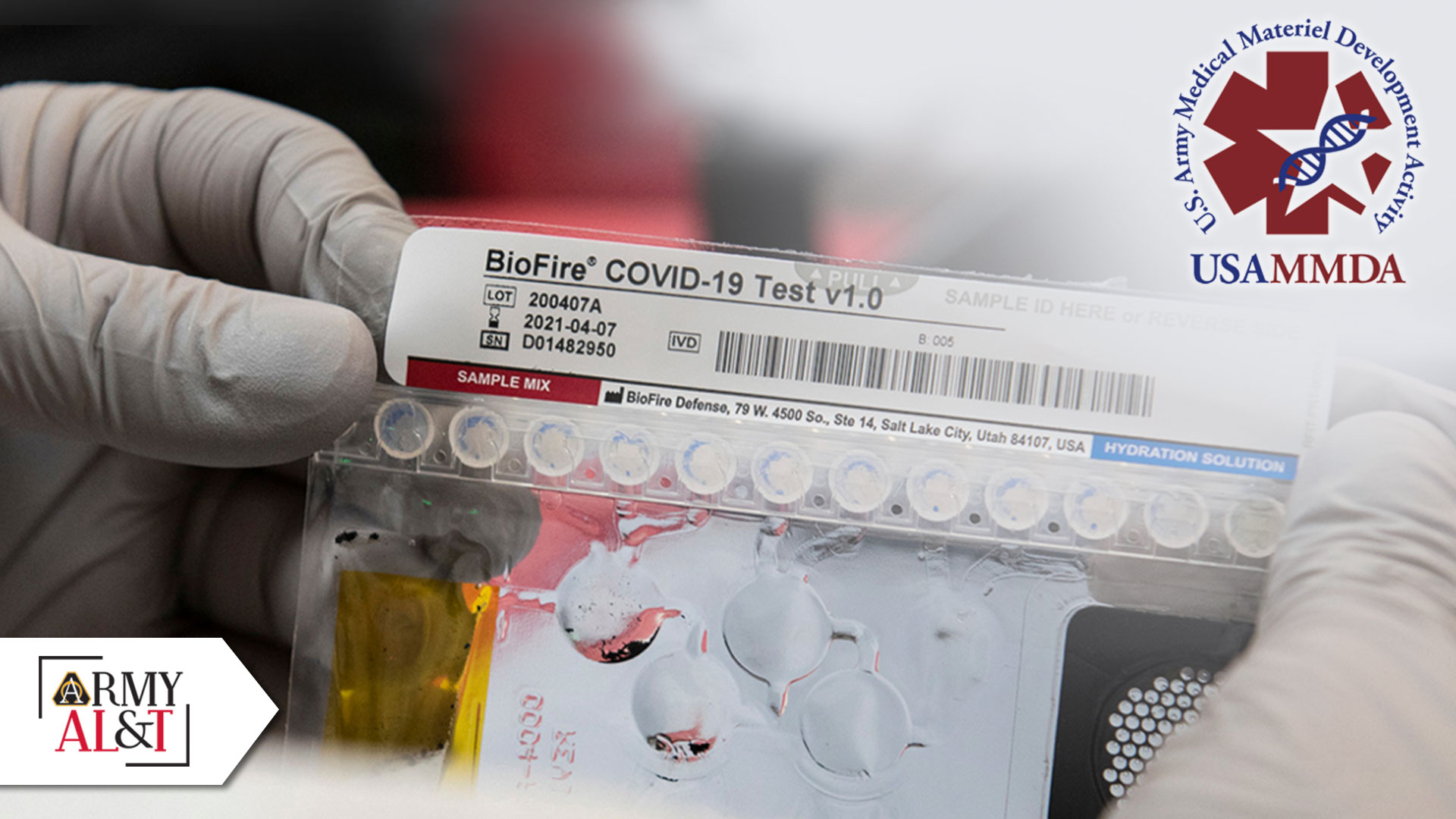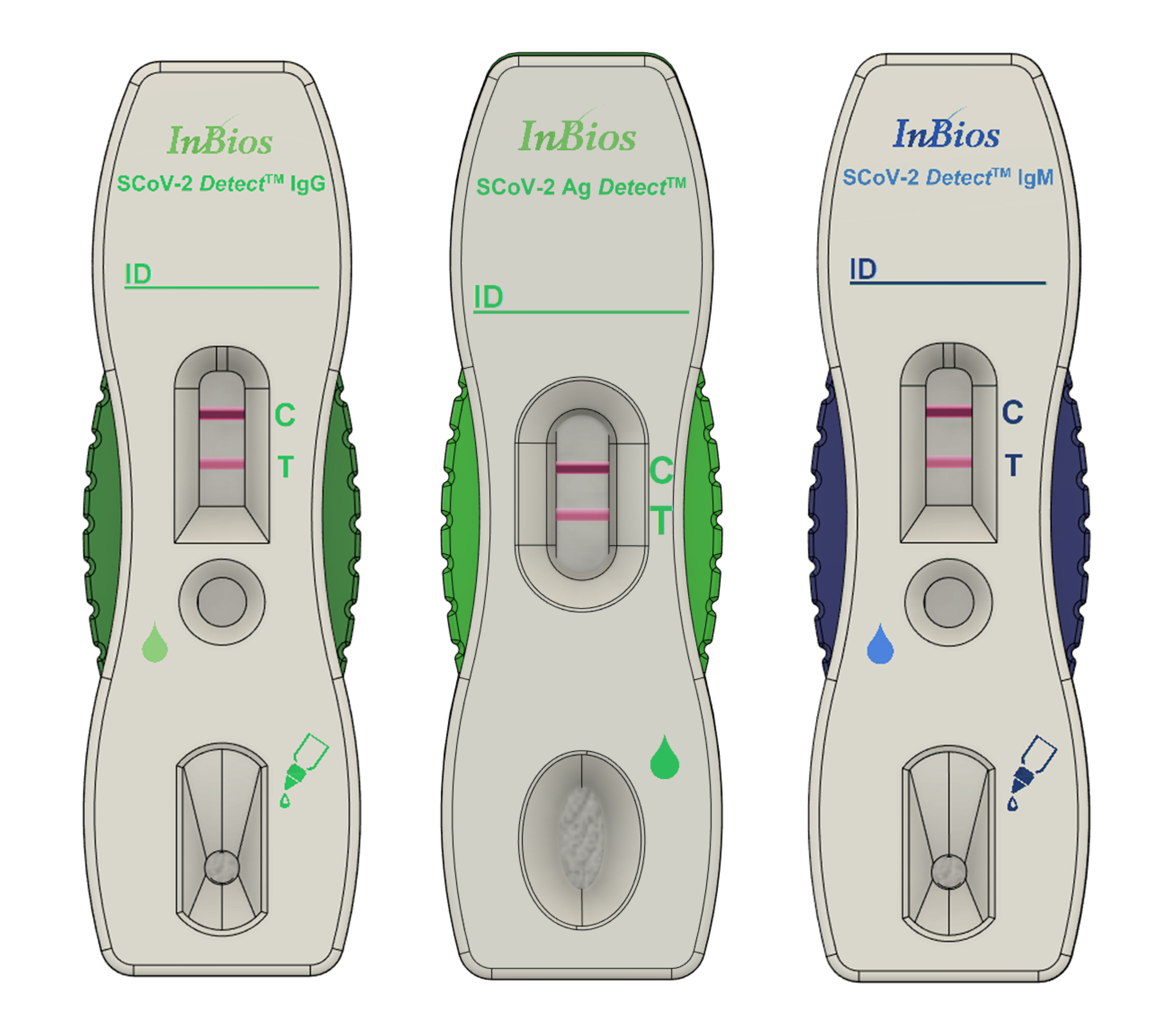
There may never be a silver bullet for defeating COVID-19—instead, it may require defense in depth, including three possible weapons from USAMMDA.
by Carey A. Phillips
The U.S. Army Medical Materiel Development Activity’s Warfighter Protection and Acute Care (WPAC) Project Management Office (PMO) has taken on many infectious diseases over the years, successfully developing drugs and devices to prevent, diagnose and treat diseases such as malaria, adenovirus types 4 and 7, and leishmaniasis—just to name a few. So when COVID-19 emerged, the WPAC team did not hesitate to take on the challenge of improving COVID detection and treatment options.
“Improved detection and drug treatment options are important tools to our warfighters and the nation in the fight against SARS-CoV-2, the virus that causes COVID,” said Dr. Lawrence Lightner, project manager for the WPAC PMO. “Diagnostics and treatment drugs will help prevent the further spread of SARS-CoV-2 and can potentially save lives of those infected.”
In May 2020, the Defense Health Agency (DHA) selected 10 projects to receive Tier 1 acquisition program investments to support the COVID-19 efforts. DHA stood this program up in response to COVID-19, as a way to rank proposals and choose which to apply initial funding. The Tier 1 acquisition program investments aim to supply testing capabilities that can be rapidly deployed, as well as to improve existing testing capabilities, vaccines and treatments. The WPAC group submitted several projects for consideration, and three projects were selected.
Comprised of military, civilian and contractor personnel, the WPAC group works together to develop and deliver infectious disease drug treatments, vaccines and diagnostics to protect and sustain our nation’s warfighters. The group is applying the DHA funding to improve capabilities to detect the COVID virus and the body’s response to it, as well as to develop a candidate treatment.
The three WPAC projects selected to receive Tier 1 acquisition program investments are:
- The phospholipase A2(PLA2) inhibitor, varespladib, for SARS-CoV-2-related acute respiratory distress syndrome Acute respiratory distress syndrome is marked by inflammation and fluid build-up that diminishes oxygen supply and causes lung dysfunction.
- FDA approval of the BioFire Defense COVID-19 test using the statutory 510(k) pathway with Sample Type Expansion under Emergency Use Authorization. The 510(k) pathway is one mechanism for attaining FDA approval.
- The SARS-CoV-2 Rapid Diagnostic Lateral Flow Tests for direct antigen detection and serology. A lateral flow diagnostic test is essentially a “test strip” where a patient sample and sample buffer, liquid, is applied to one end of the strip, which then indicates a positive or negative result.

EMERGENCY USE AUTHORIZATION: The BioFire Defense COVID-19 test was authorized for emergency use on March 23, 2020 by the U.S. Food and Drug Administration. The test is performed on the BioFire FilmArray instrument, which is already present in many DOD facilities. (Photo courtesy of BioFire Defense)
PLA2 Inhibitor for SARS-CoV-2-related acute respiratory distress syndrome—varespladib
The secreted PLA2, varespladib, for SARS-CoV-2-related acute respiratory distress syndrome treatment is a small-molecule drug that dampens activity of the molecule called phospholipase A2. Small-molecule drugs have a low molecular weight, generally meaning they can be taken orally. PLA2 is associated with inflammation, other impairments and destruction in the lung, characteristic of acute respiratory distress syndrome. COVID-19 is one of several diseases that results in acute respiratory distress syndrome, which leads to the degradation of lung function, inadequate oxygen supply and frequently, severe long-term breathing problems and even death.
Together with the industry partner, Ophirex, Inc., the WPAC PMO is working to develop varespladib as an acute respiratory distress syndrome preventative and treatment for COVID-19 patients. The intent of drug treatment is minimized hospitalization, critical care treatment and survival of COVID-19 patients. While PLA2 is a major component of snake venom, humans also produce PLA2. For us, it acts in a pro-inflammatory cascade and in disintegration of lung surfactant, a protective layer that prevents fluid retention in the lungs. PLA2 inhibition is therefore hypothesized to reduce inflammation and protect or restore surfactant to aid lung function.
On June 19, 2020, USAMMDA and the U.S. Army Medical Research Acquisition Activity (USAMRAA), subordinate commands of the U.S. Army Medical Research and Development Command, awarded Ophirex, Inc., a $9.9 million contract to manufacture two versions of the drug—a tablet and an injectable version—to be tested in clinical trials starting this year. The tablet, to be taken orally, is intended to treat moderate or recovering cases. The injectable version can be infused into patients with more severe symptoms.
“This drug doesn’t kill SARS-CoV-2. Instead, it is anticipated to stop what the virus does to the body—the symptoms of COVID-19 that are killing people and keeping them in the hospital,” said Dr. Lindsey Garver, product manager for this effort within the WPAC Project Management Office. “Since it’s already been studied for other purposes, we know a lot about its safety profile and can move very quickly to implementation and, hopefully, saving lives.”
Varespladib is currently being evaluated as a treatment for venomous snakebites. It was previously tested against sepsis and acute coronary syndromes—trials which showed it to be safe and well-tolerated in patients, though not particularly effective in those conditions.
Regulatory progression of BioFire Defense’s COVID-19 test and Sample Type Expansion
The U.S. Food and Drug Administration (FDA) authorized the BioFire Defense’s COVID-19 test for emergency use on March 23, 2020. The test provides a “detected” or “not detected” report about 50 minutes after a sample, collected via a nasopharyngeal swab in transport medium, is loaded for analysis. The test is performed on the BioFire FilmArray instrument, which is already present in many Department of Defense facilities.
“We are capitalizing on the work done by our colleagues at JPEO-CBRND [Joint Program Executive Office for Chemical, Biological, Radiological and Nuclear Defense] earlier this year, when they partnered with BioFire Defense to start the development of the COVID-19 test,” said Dr. Clifford Snyder, product manager for this effort within the WPAC PMO. “This test detects SARS-CoV-2 nucleic acid with a high degree of specificity and sensitivity. The virus can’t hide from this test.”
The FDA’s emergency use authorization allows this test to be used, however, the 510(k) route to FDA clearance, which involves the acquisition of additional performance data, will provide additional confidence in the accuracy of test results and support use of the test even after the COVID-19 emergency expires. The WPAC group worked closely with USAMRAA to finalize BioFire Defense’s commitment to perform the required studies. On June 4, 2020, a $3.1 million contract was awarded to BioFire Defense, with completion expected by June 2021.
WPAC has also initiated work on expansion of the range of sample types for the COVID-19 test, in order to address challenges associated with obtaining nasopharyngeal swab specimens, possible shortages of swabs and viral transport medium, and to examine whether the testing of additional sample types might otherwise be advantageous. On October 14, 2020, USAMRAA issued a contract to BioFire Defense to support investigation of the use of its COVID-19 test with nasal swabs, throat swabs, sputum and saliva—the contract value of those efforts is $1 million.
“Our objective is to wring every bit of value we can out of this test. Our users deserve nothing less,” said Snyder.

TEST CREATION: Tests currently in development by InBios International will be able to identify persons infected with SARS-CoV-2. Each of these tests will provide results within 15 to 30 minutes of sample collection. (Images courtesy of InBios International)
SARS-CoV-2 Rapid Diagnostic Lateral Flow Tests for direct antigen detection and serology
The SARS-CoV-2 Rapid Diagnostic Lateral Flow Tests for direct antigen detection and serology includes two point-of-care diagnostic tests that will be able to identify persons infected with and infer recent or prior infection with SARS-CoV-2. These tests are the SCoV-2 Ag Detect and SCoV-2 Ab Detect, and both will be able to provide results within 15 to 30 minutes of sample collection.
Collected by nasopharyngeal swab, the SCOV-2 Ag Detect is a direct antigen-based test that uses a proprietary dipstick-like test to detect several SARS-CoV-2 antigen targets present in respiratory samples.
The SCoV-2 Ab Detect is also a dipstick-like serology test that will use blood collected by finger stick to detect SARS-CoV-2-specific immunoglobulin M and immunoglobulin G antibodies in individuals who meet either clinical or epidemiological criteria to infer recent or prior infection in accordance with FDA guidelines.
Leveraging its existing indefinite delivery and indefinite quantity contract with InBios International, USAMMDA awarded a task order on June 15, 2020, for $11.9 million to support the development of both of these diagnostic tests to achieve emergency use authorization and ultimately 510(k) clearance with the FDA. The DHA is funding development activities occurring in the 2020 fiscal year for emergency use authorization. To support and fund fiscal year 2021-2022 development activities to achieve FDA 510(k)-clearance, USAMMDA has partnered with the U.S. Department of Health and Human Services’ Biomedical Advanced Research and Development Authority.
The intent is to improve testing to deliver faster, more accurate detection of SARS-CoV-2. This can streamline surveillance of virus transmission, minimizing the COVID patient’s time in quarantine, reducing asymptomatic contact and relieving the burden on testing labs.
CONCLUSION
The Department of Defense is committed to protecting the health and safety of our warfighters, as well as to leveraging our unique capabilities and partnerships that strengthen the whole-of-government approach to fighting the worldwide COVID-19 pandemic.
“USAMMDA teams work every day to develop and deliver a broad array of lifesaving medical products for our warfighters,” said Col. Gina Adam, USAMMMDA commander. “The WPAC PMO’s efforts showcase this breadth and the development of promising technologies to save lives across the nation.”
The successful development of these projects is intended to benefit both military and civilian populations. With a mission to develop and deliver quality medical capabilities to protect, treat and sustain the health of our nation’s service members, USAMMDA remains focused on providing life-saving drugs and devices that meet or exceed the intended requirements of the DOD. Without question, the men and women of the WPAC PMO team serve to highlight the determination and proficiency of the entire organization.
For more information on the Warfighter Protection and Acute Care Project Management Office and other projects being developed by the U.S. Army Medical Materiel Development Activity, visit the USAMMDA website at https://www.usammda.army.mil/.
CAREY A. PHILLIPS is chief of public affairs for the U.S. Army Medical Materiel Development Activity, Fort Detrick, Maryland. She has been with USAMMDA for the past 12 years, having previously served in the U.S. Navy as a mass communications petty officer, second class. She holds a B.A. in visual communications from Framingham State College in Framingham, Massachusetts and an M.S. in management with a concentration in marketing from University of Maryland, University College.
Read the full article in the Winter 2021 issue of Army AL&T magazine.
Subscribe to Army AL&T News – the premier online news source for the Army Acquisition Workforce. ![]() Subscribe
Subscribe







